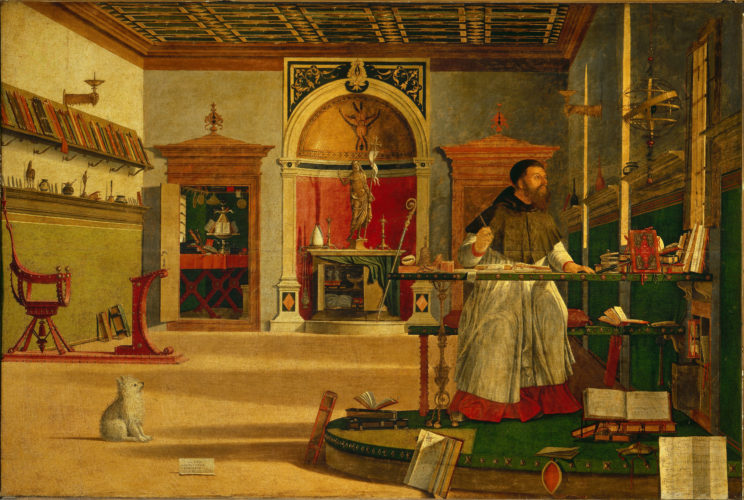This painting presents a scholar at his desk, strewn with objects of study. He is in a room radiant with warm light, and filled with books, music notations, astrolabe and armillary sphere, an hour-glass, other scientific instruments, little sculptures and figurines and ornaments on the bookshelf - all tokens of humanist culture and learning. In the closet in the far left corner, with a table and more books and instruments, we glimpse a still more private space for study. On the altar in the niche in the centre of the background, there are liturgical objects and a bronze statue of Christ. Together, these elements recreate a space of knowing at once vividly real and full of symbolic suggestion.
The figure at the desk is St Augustine. He looks, startled, towards the invisible window through which the light streams in. There, beyond our gaze, is St Jerome, appearing in a vision and interrupting Augustine’s letter-writing – a letter addressed to Jerome himself. Jerome, in an apparition, has brought him the knowledge that he is about to leave this world, with all its learning and richness, and ascend to heaven. The little dog follows the direction of Augustine’s gaze and seems to look at the vision too. Or does he just look at his master? What alternative knowledges does the shaft of light bring or embody, and how does it relate to the material artefacts of knowledge in the study of the scholar-saint?
While the relation between Augustine and his dog, and between Jerome and Augustine, are poignantly evoked, the humanist study itself is an unmistakeably male space, recalling the French philosopher Michel de Montaigne’s famous passage on the arrière-boutique (in his essay, ‘On Solitude’) - literally a room at the back of a shop (and by extension, a closet) - where the introspective Renaissance man retreats from worldly affairs into solitude and thought. It is interesting to contrast the female space in the final image of this section – Sor Juana’s study, from the end of the seventeenth century.











